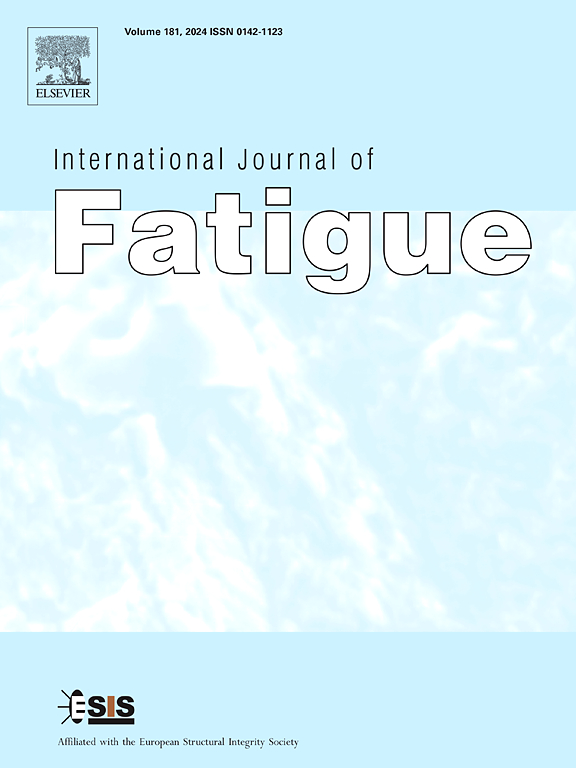Evolution behavior of competing fatigue failure and life prediction related to defect, stress and temperature for laser powder bed fused superalloy with solution aging treatment
IF 5.7
2区 材料科学
Q1 ENGINEERING, MECHANICAL
引用次数: 0
Abstract
Laser powder bed fusion (LPBF) provides advanced manufacturing capabilities for nickel-based superalloy, and solution aging treatment enhances its mechanical properties. However, the fatigue properties of solution-aged LPBF nickel-based superalloy at elevated temperature are not fully well understood. Here, high-cycle and very-high-cycle fatigue tests are conducted at 650 °C with stress ratios of R = −1 and 0.1. Microstructures and fatigue fractures are analyzed using various techniques, including scanning electron microscopy, X-ray computed tomography, electron backscatter diffraction, and three-dimensional ultra-depth of field imaging. The results indicate that solution aging blurs the laser tracks and melt pool prevalent in the LPBF process. The synergistic interaction of δ, γ′, and γ″ phases improves fatigue properties. Four defect-induced internal failure modes caused by facet, pore, lack of fusion, and inclusion are revealed. Internal microcracks grow in a trans-granular fracture mode under shear forces. The aggregation of facets formed during crack growth is a typical feature of internal failure. Interestingly, even for internal failures, the crack nucleation site gradually shifts from the subsurface to the center as the stress level decreases, accompanied by an increase in the facetted cracking area. A fatigue life prediction model related to the effects of defect features, stress, and temperature is established.
激光粉末床固溶时效高温合金竞争疲劳失效演化行为及与缺陷、应力和温度相关的寿命预测
激光粉末床熔合技术为镍基高温合金提供了先进的制造能力,而固溶时效处理则提高了镍基高温合金的力学性能。然而,液相时效LPBF镍基高温合金的高温疲劳性能尚不完全清楚。在650℃下进行高周和甚高周疲劳试验,应力比分别为R = - 1和0.1。显微组织和疲劳断裂分析使用各种技术,包括扫描电子显微镜,x射线计算机断层扫描,电子背散射衍射和三维超景深成像。结果表明,溶液老化模糊了LPBF过程中普遍存在的激光轨迹和熔池。δ、γ′和γ″相的协同作用改善了材料的疲劳性能。揭示了四种缺陷引起的内部破坏模式,包括小面、孔隙、缺乏融合和夹杂。内部微裂纹在剪切作用下以穿晶断裂模式生长。裂纹扩展过程中形成的切面聚集是内部破坏的典型特征。有趣的是,即使是内部破坏,随着应力水平的降低,裂纹形核位置也逐渐从地下向中心转移,同时面状裂纹面积也在增加。建立了考虑缺陷特征、应力和温度影响的疲劳寿命预测模型。
本文章由计算机程序翻译,如有差异,请以英文原文为准。
求助全文
约1分钟内获得全文
求助全文
来源期刊

International Journal of Fatigue
工程技术-材料科学:综合
CiteScore
10.70
自引率
21.70%
发文量
619
审稿时长
58 days
期刊介绍:
Typical subjects discussed in International Journal of Fatigue address:
Novel fatigue testing and characterization methods (new kinds of fatigue tests, critical evaluation of existing methods, in situ measurement of fatigue degradation, non-contact field measurements)
Multiaxial fatigue and complex loading effects of materials and structures, exploring state-of-the-art concepts in degradation under cyclic loading
Fatigue in the very high cycle regime, including failure mode transitions from surface to subsurface, effects of surface treatment, processing, and loading conditions
Modeling (including degradation processes and related driving forces, multiscale/multi-resolution methods, computational hierarchical and concurrent methods for coupled component and material responses, novel methods for notch root analysis, fracture mechanics, damage mechanics, crack growth kinetics, life prediction and durability, and prediction of stochastic fatigue behavior reflecting microstructure and service conditions)
Models for early stages of fatigue crack formation and growth that explicitly consider microstructure and relevant materials science aspects
Understanding the influence or manufacturing and processing route on fatigue degradation, and embedding this understanding in more predictive schemes for mitigation and design against fatigue
Prognosis and damage state awareness (including sensors, monitoring, methodology, interactive control, accelerated methods, data interpretation)
Applications of technologies associated with fatigue and their implications for structural integrity and reliability. This includes issues related to design, operation and maintenance, i.e., life cycle engineering
Smart materials and structures that can sense and mitigate fatigue degradation
Fatigue of devices and structures at small scales, including effects of process route and surfaces/interfaces.
 求助内容:
求助内容: 应助结果提醒方式:
应助结果提醒方式:


